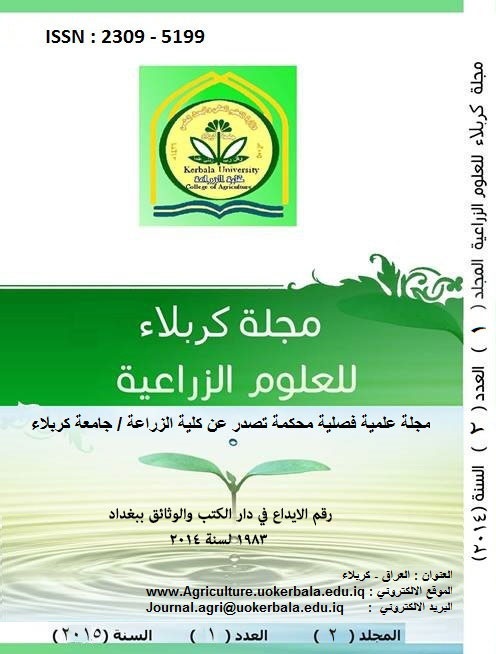Estimation of heterosis and combining ability by half diallel crossing in maize .
DOI:
https://doi.org/10.59658/jkas.v2i1.466Keywords:
الذرة الصفراء , القابلية الاتلافية , التبادل النصفي , قوةAbstract
Six inbred lines of corn (Zea mays L.) were studied planted (S6 , HS , AGR183 , ZP607 , ZM19R and ZM43R( to attain hybridization program of (Half – Diallel Cross). The research included 21 genotypes (6 parents + 15 hybrids) grown in fields of farmers field in AL- sofia area in east of Ramadi city in AL –anbar for spring season 2013 by using RCBD design with three replications , to study heterosis and combining ability for characters (number of days to female flowering , number of plant ears, number of row grains, weight of 300 grains and individual plant yield .
The research showed that there were significantly differences at for all characters, also showed that the hybrids (ZM43R×AGR183) , (AGR183×HS) showed desired heterosis for most characters studied as compared with mid parents . Two parents (HS and AGR183) showed general combining ability effects,while the hybrids (S6×HS) ‘ (ZP607×ZM43R) ، (AGR183×ZM43R) and (HS×AGR183( were showed high specific combining ability effects in most of the studied characters .
Downloads
Published
How to Cite
Issue
Section
License
Copyright (c) 2015 Copyright (c) 2024 is the Author's article. Published by the Journal of Kerbala for Agricultural Sciences under a CC BY 4.0 license

This work is licensed under a Creative Commons Attribution 4.0 International License.
Licensing Terms
All articles are published under a Creative Commons License and will be directed to the Creative Commons Attribution 4.0 International License (CC BY 4.0) That permits use, distribution, and reproduction in any medium, provided the original work is properly cited. This license also allows the work to be used for commercial purposes.
Use by both non-commercial and commercial users
This content is licensed under a Creative Commons Attribution 4.0 International (CC BY 4.0) license, permitting use by both non-commercial and commercial users. Individual users may access, download, copy, display, and redistribute the articles to colleagues, as well as adapt, translate, and text- and data-mine the content, subject to the following conditions:
- The author's moral rights, including the right of attribution and the right to protect their work from derogatory treatment, are respected.
- Where content in the article is identified as belonging to a third party, users must ensure that any reuse complies with the copyright policies of the owner of that content.
- If the article content is reused for research or educational purposes, users should maintain a link to the appropriate bibliographic citation, including the DOI and a link to the published version on the journal's website.

